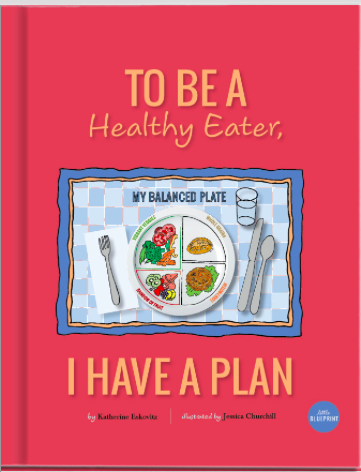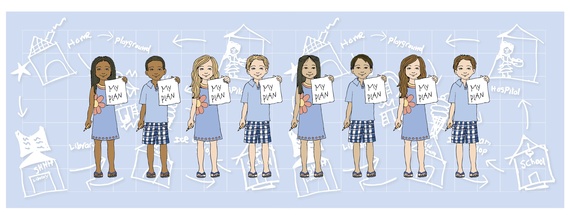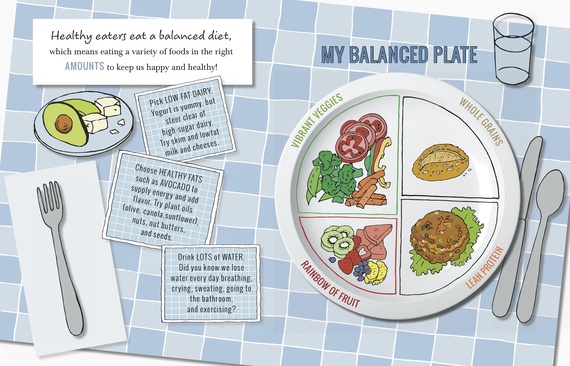Why is it that children's menus at restaurants in our country seem to offer almost exclusively unhealthy food for our children? And public school cafeterias are among the worst, serving high-fat, high-sodium, high-sugar, low-fiber menus. It is no wonder childhood obesity has more than doubled in the past 30 years.

(c) 2014, little BLUEPRINT, illustration Jessica Churchill
As parents, we need to help our children become healthy eaters, starting at a young age. But in order to do that, we've got to make them an active part of the process. We need to empower our children to develop their own plan to become healthy eaters, teaching lifelong skills rather than merely forcing upon them some healthy food on occasion. It is a prime opportunity to help children develop through practice the critical skills necessary to create meaningful plans for any situation they encounter in life, and acquire long-term healthy eating habits in the process.
The ability to plan meaningfully and intentionally -- the executive function skill that occurs in the pre-frontal cortex of the brain -- can be strengthened with practice. To plan requires focus, analysis, decision-making, and self control. Children cannot be effective learners without these skills. It is therefore not surprising that executive function skills, and not IQ scores, are increasingly considered the best predictor of success. Yet opportunities to practice these skills are too often overlooked at school and at home.
Nutrition is such a great area for children to practice planning. It not only helps children become healthy eaters beyond the childhood years, but it strengthens these high-level cognitive skills as they are developing. Children become cooperative problem-solvers rather than opponents of parents. They feel a sense of ownership and control over an area of their life. They develop grit by persevering to achieve a goal that is not easy to accomplish. They learn how to become learners.
 (c) 2014, little BLUEPRINT, illustration by Jessica Churchill
(c) 2014, little BLUEPRINT, illustration by Jessica Churchill
How exactly does this work? By deconstructing effective decision making in the area of nutrition, we can help our children practice their emerging executive function skills. In essence, we can teach our children to L.E.A.D. the way to becoming lifelong healthy eaters by practicing four steps that integrate key systems of the brain:
1. Logic: learn facts about nutrition
Children need to learn facts about nutrition starting at a young age. In To Be a Healthy Eater, I have a Plan, I teach children facts, including: (1) food groups, (2) the dangers of sugar and how to look for added sugar on food labels, (3) the importance of being active, (4) what makes whole grains healthier, and (5) research demonstrating that you can change your taste to like more healthy foods by consistently trying a food for fourteen days in a row. There are so many useful facts children can learn about nutrition. Talk about them, read them aloud, teach them to children.
2. Emotions: explore how food makes us feel
There are emotions attached to eating for all of us, and making children aware of this at a young age will help ensure that feelings do not dictate eating habits. Do we eat to satisfy hunger or to deal with how we are feeling? And how do we actually feel when we eat a lot of food that is bad for our body? Being mindful of the emotions attached to any situation is an important step to self-awareness and self-control.
3. Analysis: analyze suggestions for healthy eating
There are so many fun suggestions for kids to choose from when developing their own plans, and each suggestion teaches social and intellectual skills along the way. Among the ones I teach children to consider as part of their little blueprint for healthy eating are:
• Keep a journal of foods you eat, markets you visit, and recipes you try;
• Take the Taste 14 Challenge by trying a small bite of a healthy food you don't like for fourteen days in a row;
• Read food labels, cut them out and circle the added sugar and chemicals;
• Eat more whole foods and less processed foods -- plant a garden;
• Be a smart snacker and discriminating dessert eater by eating healthy treats with less sugar and more vitamins and minerals; and
• Be active: jump rope, dance, play a sport.
The possibilities are endless, and once children are exposed to suggestions, they are open to coming up with their own.
4. Decision-making: decide on your own plan for becoming a healthy eater
This key step is where children integrate the key systems of the brain, using their logic and emotions to analyze and decide on their own plan. By practicing creating their own plans, children are now actively part of the process: they are reviewing what they have learned, they are becoming aware of the emotions of themselves and others, they are analyzing suggestions, and they are drawing or writing down their ideas. And amazingly, with our assistance, children can practice all of these skills starting at age three all the way through adulthood.

(c) 2014, little BLUEPRINT, illustration by Jessica Churchill
Now, when I go to a restaurant with my children and the kids' menu is offering essentially junk food, I challenge my children to look at the adult menu with me and think about a meal that is delicious and healthier that perhaps could be shared. I do not dictate their choice or limit them to choices that are unhealthy simply because they are on the kids' menu. They are learning to think critically and eat healthy. And to me, that's the best recipe for success.
Endnotes:
[1] Carroll MD, Kit BK, Flegal KM. Prevalence of childhood and adult obesity in the United States, 2011-2012. Journal of the American Medical Association 2014;311(8):806-814.
[2] Dawson and Guere, "Executive Skills in Children and Adolescents: A Practical Guide to Assessment and Intervention," at vii (2010).
[3] Sadeh Ss et al., "Examining an executive function rating scale as a predictor of achievement in children at risk for behavior problems," Sch Psychol Q, (Dec. 2012).
[4] Tips excerpted from children's book: To Be a Healthy Eater, I Have a Plan, by Katherine Eskovitz. Available at www.littleblueprint.com and Amazon.
[5] It is inspiring to see plans/blueprints created by children, and to watch children learn from their peers as they create their next plan. https://www.littleblueprint.com/submitblueprintlist
[6] "Building the Brain's 'Air Traffic Control' System: How Early Experiences Shape the Development of Executive Function, " Harvard University Center on the Developing Child, at 13 (2011).